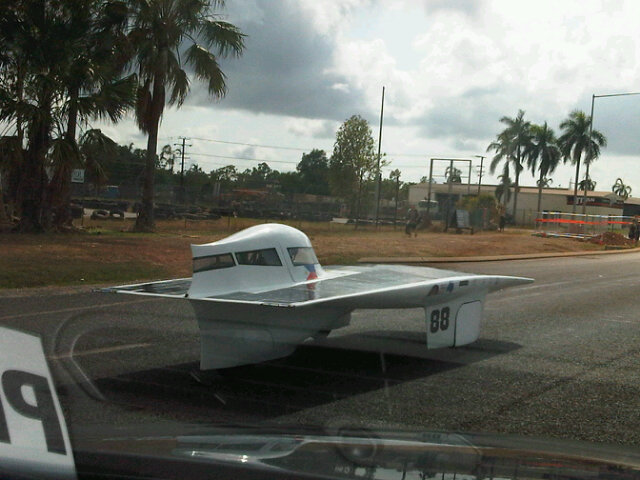Solar-powered PHL car racing against world's best
A Philippine-made car is competing in one of the most revolutionary racing events in the world... and also among the quietest. The Sikat II solar car developed by De La Salle University engineering students and faculty will be racing in the 3,000-kilometer 11th World Solar Challenge (WSC) in Australia starting Sunday. The biannual race draws innovators from all over the globe to show what long-distance transport can be in an oil-depleted future. It also promises to be an adventure for the racing teams, with camping in the desert and the occasional kangaroo darting onto the race route, which stretches from Darwin in Australia's northern tip to Adelaide on the country's southern coast. Unlike the roar of conventional internal combustion engines that run on fossil fuels, electric cars powered by solar energy like the Sikat II simply hum even at its top speed of 110 kilometers per hour. [See related story, PHL solar car evolution: From 'Sinag' to 'Sikat II'] The Sikat II is also a statement of solar energy's state of the art in the Philippines, where university researchers are harnessing the cutting-edge advantages of solar cells made locally. The country is a growing exporter of solar panels and other technologies. The Philippines’ solar car and the team running it, Team Solar Philippines, are competing against vehicles backed by some of the world’s leading universities. Tokai University, Stanford University, the Massachusetts Institute of Technology, University of Michigan, Cambridge University, University of Toronto are among the top-notch institutions registered in the race. When the country joined the race for the first time in 2007, it placed 12th in a field of 40. Tokai University's "Tokai Challenger" won the race in 2009. DLSU professor and Sikat II team leader Jose Antonio “Jack" Catalan told GMA News Online via phone interview that their solar car passed the pre-race “dynamic tests" to determine vehicle stability and road-worthiness. Those tests covered steering, braking and performance. A “hot lap" on the track of the Hidden Valley Motorsport Complex near Darwin in northern Australia followed the dynamic scrutiny to determine the starting position on Sunday. Catalan said the team will strive to achieve optimum energy efficiency so that Sikat II's solar cells will have enough power to last until the end of the race.

(24 Oras video report on Sikat II on August 8, 2011) Solar power plus Lasallian spirit Team Solar Philippines is made up of about a dozen faculty and students of DLSU. They operate Sikat II, the third generation of Philippine solar cars to compete in the WSC. The team and their colleagues in the DLSU College of Engineering, with the support of collaborators in the Philippine Solar Car Challenge Society (PSCCS), spent at least seven months to prepare for the race from Darwin to Adelaide through the Australian Outback. Sikat II, which cost about P6 million to build, sports a more aerodynamic design, weighs 180 kilograms, and has more efficient solar power mechanisms, according to the DLSU team. Sikat II runs on a 1.8-kilowatt motor and has top speed of 110 kilometers per hour (kph). The maximum speed limit at some sections of the Stuart highway, through which the race will run, is 130 kph. Sinag, the vehicle that ran the race in 2007, was heavier at 290 kilograms and had a solar array that was two percentage points less efficient than Sikat II's. The president and CEO of De La Salle Philippines, Bro. Ricardo Laguda, FSC is in Australia to support the team on behalf of the Filipino Lasallian community. Also in Australia to support the team is PSCCS president Ramon Agustines, team manager of the Philippine contingent, and the World Wide Fund for Nature (WWF) – Philippines, which sent Nini Conwi, the winner of an essay writing contest about Sikat II, to write about the team’s experience in the 11th WSC. Weather in the Land Down Under Strong thunderstorms and mostly cloudy skies are forecast over Darwin on Sunday. More clouds are also expected over Katherine, the first checkpoint along the race course. However, sunny skies are expected up ahead over Tennant Creek and Alice Springs as the course goes through the desert sections of the Australian Outback.
View The Journey of Sikat II in the World Solar Challenge 2011 in a larger map Safety always Organizers advised the registered teams and media covering the WSC to practice road safety while on the course. "In stage one of the race, the road from Darwin to Katherine is windy and undulating for the first 200 kms with minimal overtaking lanes," event director Chris Selwood said. "The drive is long and monotonous. Speed, fatigue and wildlife on the roads are factors that can lead to dangerous situations," Selwood cautioned. "Do not underestimate the danger of driving during hours of darkness as cattle and kangaroos are just two of the obstacles that you may experience sharing the road with you." He further warned that "(w)hen a road train hits a kangaroo it makes a mess. When your car hits a kangaroo you could be dead too!" — ELR/HS, GMA News




